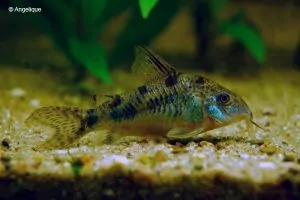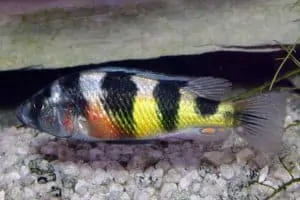Astronotus ocellatus – Oscar
Astronotus ocellatus or Oscar is usually offered in stores when they are still young, up to about 7 centimeters. However, keep in mind that this species grows to about 35 centimeters. When they are young they have a completely different pattern than the adults. They are also schooling fish that become a ball of fish when threatened. The drawing of the young animals swimming around confuses the predators. Later, when they grow up, the schools fall apart.
The difference between male and female is very difficult to recognize, an adult female can only be recognized by the sexual papilla during the mating season. Males sometimes have dark stripes on the base of the dorsal fin. They are usually still quite small when purchased, but they grow quickly. As they get older, they lose many of their colors, but the black dot on its caudal fin remains. Their common name is Oscar.
Synonyms: Lobotes ocellatus, Astronotus ocellatus ocellatus, Cychla rubroocellata, Acara compressus, Acara hyposticta, Astronotus ocellatus zebra, Astronotus orbiculatus.
Origin
Rio Paraguay, Rio Negro, Rio Paraná, Argentina, Peru, Brazil, French Guiana, Amazon.
You can find the Astronauts ocellatus or Oscar, in a vast area of South America. They inhabit the Amazon and Orinoco river basins in French Guiana, Paraguay, Peru, Colombia, Uruguay and Venezuela. The Oscar can be found in clear water, black water, cloudy water, stagnant or slow-flowing water, lakes, streams, and rivers, but they also inhabit flood areas.
They usually live above a sandy bottom that is strewn with wood, branches, roots, and pebbles, with or without plants. Since Kullander’s study in 1986, the variant from Paraguay belongs to the Astrolotus crassipinnis. In addition to the “eye” on the caudal peduncle, they also have eyespots on the dorsal fin.
The Aquarium
The Oscar requires an aquarium of at least 2 meters. Furnish the aquarium with a thick layer of fine round gravel (not sharp gravel), driftwood, stones and some stronger plants. They like to dig around in the substrate and will not leave the plants and roots alone, so it is best to place the plants in earthenware pots in the gravel and place some heavy stones on top. Because they like to dig and eat a lot, good filtration is necessary, and regular water changes are recommended. Be sure to use cover windows, because they can easily jump out of the water.
Due to the large amounts of food, very regular water changes and a large filter are required!
Water parameters
Temperature: 23-26 degrees Celsius.
PH: 6-6,5
GH: 8-12
In nature, fish have to deal with fluctuating temperatures. Keeping fish at the minimum or maximum temperature for a long time is not always desirable and can shorten the average lifespan of the animals.
Diet
Its slightly upward-pointing mouth is wide and large. Astronotus ocellatus eats large chunks at a time. In the wild they eat fish, crayfish, insects (sometimes they even jump out of the water to get them), mosquitoes and insect larvae. In the aquarium, they should therefore be given a varied menu that can include: whitefish (frozen), squid, mussels, krill, white and red mosquito larvae, cichlid sticks, etc. These fish always seem to be hungry, be careful not to give them too much.
After a heavy meal, the Oscar may digest it leisurely and lie on the bottom. So don’t panic if this happens! Do not keep them together with Corydoras, they will try to eat the Corydoras and choke because they get stuck in their throat due to the spiky fins.
The Astronotus ocellatus is sensitive to hole-in-the-head disease. To prevent this disease, you can add vitamin C to its food.
Character
These territory formers are large, peaceful fish, even towards conspecifics and other fish. You can keep them in a pair or in a group. Keep together with cichlids or catfish of approximately the same size, smaller fish are mistaken for food.
Breeding Astronotus ocellatus
In the Oscar, the gender is only visible during mating. If you want to breed, it is best to let 4 or more youngsters grow up together. Couples will then separate automatically. Preferably use fish from different origins to prevent inbreeding.
The eggs are deposited on a flat stone or boulder. The 500 to 1000 yellow-white eggs are slightly sticky and hatch after a few days. The parents then move them to pre-dug pits. The young can initially be fed with cyclops and brine shrimp nauplii. Once they get bigger you can feed them with whatever fits in their mouth. The young grow quite quickly.
There are various breeding forms of these fish, including the orange-red albino breeding variant.
Video
Author
Coby – John de Lange
Copyright images
John de Lange
Ben Lee – Amiidae.com
AquariumGlaser.de
























Reviews
There are no reviews yet.